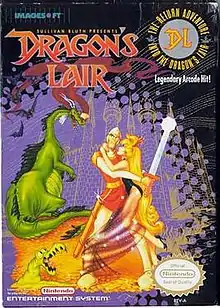Dragon's Lair (1990 video game)
Dragon's Lair[lower-alpha 2], titled as Sullivan Bluth Presents: Dragon's Lair on the cover art and in-game as Sullivan Bluth's Dragon's Lair or Don Bluth's Dragon's Lair, is a cinematic platform video game developed by Motivetime and published by CSG Imagesoft for the Nintendo Entertainment System. Based on the LaserDisc game of the same name, it is identical plotwise to the original.
| Dragon's Lair | |
|---|---|
 North American cover art | |
| Developer(s) | Motivetime |
| Publisher(s) | |
| Programmer(s) | Andy Williams |
| Artist(s) | David Percival |
| Composer(s) | Mark Cooksey |
| Series | Dragon's Lair |
| Platform(s) | Nintendo Entertainment System |
| Release | |
| Genre(s) | Cinematic platformer |
| Mode(s) | Single-player, multiplayer[lower-alpha 1] |
Gameplay
The game is a side-scroller with the character walking slowly. Dirk can walk, crawl, or jump forward, and he has an array of weapons that he can discover and use to dispose of enemies. The controller layout is reversed from other mainstream NES titles, with Select functioning as the Pause button while Start is used for the Candle object (which helps reveal hidden weapons). Also, B is used for jumping, and A for attacking (the input of the A & B buttons is almost always the opposite in similar NES games). In the Japanese version, the controls have been altered; the Up button jumps while the B button uses the candle.
Areas and levels
.png.webp)
There are seven areas of the castle and four main levels of play:[2]
- The Drawbridge
- The Entrance Hall (Level 1)
- The Treasury
- The Elevator Shaft
- The Gold Mines (Level 2)
- The Hall of the Grim Reaper (Level 3)
- Singe's Cavern (Level 4)
- The Lizard King's Throne Room (bonus level)
Regional differences
PAL and Famicom versions have faster gameplay than the original North American release due to improved framerate.[3][4] Both versions also use 256KB ROMs compared to the US's 128KB ROM.[4] Furthermore, the PAL version has also additional enemies in The Entrance Hall level: spiders, flying insects, and a giant snake boss at the end; new death animation (when Dirk gets flattened); splash screens that appear as the player enters each level (beside The Dungeon stage); and The Elevator Shaft area has increased difficulty with added projectiles flying around, touching one is instant death.[4] The Japanese and PAL versions play most of the songs faster. Also, a part of the ending theme was changed.
30 Life Code
30 Life Code was added exclusively to the PAL and Japanese versions. It gives 30 lives after the player gains a high score, and then enters "BATS" as his name. The player will get the extra lives for the next game.[4]
Reception
The game was panned by critics and gamers alike due to its poor controls, trudging movement, and immense difficulty level. Gamers especially criticized the game for the player dying from one hit by any object or enemy, despite the player having an obvious health bar.
| Publication | Score |
|---|---|
| AllGame | |
| Electronic Gaming Monthly | 4/10[lower-alpha 3] |
| GamePro | 18/25[7] |
| Mean Machines | 21%[8] |
| Defunct Games | F[9] |
Notes
References
- "Dragon's Lair (Video Game 1990) - Release Info". IMDb. Seattle: Amazon. Retrieved 6 October 2019.
- Dragon's Lair Instruction Manual. CSG Imagesoft. 1990. p. 9.
- "Sullivan Bluth Presents Dragon's Lair for NES (1990)". MobyGames. Retrieved 6 October 2019.
- "Dragon's Lair (NES)". The Cutting Room Floor. Retrieved 6 October 2019.
- Baker, Christopher Michael. "Dragon's Lair - Review". AllGame. San Francisco: All Media Network. Archived from the original on 14 November 2014. Retrieved 7 January 2014.
- Harris, Steve; Semrad, Ed; Alessi, Martin; Sushi-X (March 1991). "Dragon's Lair". Electronic Gaming Monthly. Vol. 4, no. 3. p. 16.
- Aslan, Charlie T. (October 1990). "Nintendo ProView: Dragon's Lair" (PDF). GamePro. pp. 60–61.
- "Dragon's Lair Review". Mean Machines. January 1992. Retrieved 6 October 2019.
- Lachel, Cyril (22 May 2012). "Dragon's Lair Review for NES (1990)". Defunct Games. Retrieved 7 January 2014.